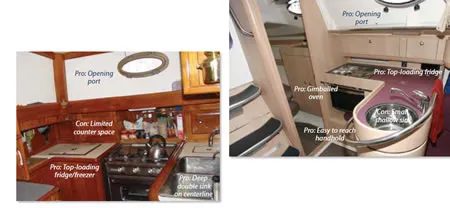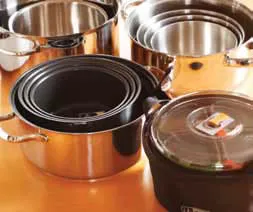Cooking a great meal in a cavernous kitchen outfitted with every imaginable culinary device can be difficult enough, but doing it in the confined space of a sailboat presents greater challenges, some the result of ill-conceived galley layouts.
But what makes up a dream galley for cooking underway? To find out, Practical Sailor interviewed full-time chefs working aboard sailboats as well as cruising sailors who have experienced first-hand the challenges of putting together a meal in a pounding sea. (For links to our past tests of the galley gear described below, check out the online version of this article.)
The Basics
In the book “Desirable and Undesirable Characteristics of Offshore Yachts,” published in 1987 by the Technical Committee of the Cruising Club of America, the authors noted that before 1970, a galley was located anywhere on a boat. Since then, however, the most typical location has been next to the aft companionway, where it is less susceptible to violent pitching motion and makes it easy to pass food from the galley to the cockpit.
Most of the galley chefs we spoke with agreed that the best place for a galley is amidships or aft. A galley too far forward takes the brunt of foul weather, turning utensils and appliances into safety hazards.
“Being forward is tough,” said full-time sailing chef Jade Konst of Vancouver Island in British Colombia, Canada. “You are constantly bucking the waves.”
She recommends outfitting a galley with cupboard shelves that pull out on sliders or have a rotating lazy Susan, making the contents easily accessible. All cupboards should have locking latches to ensure that they don’t come open unexpectedly, and a pegboard system of vertical dowels helps hold mugs and cups in place, she added.
Other suggestions from the chefs: more counter space; wall-mounted racks with fiddle rails to keep spice bottles safe but accessible; and fiddles around preparation counters that aren’t so high that it’s difficult to chop ingredients (chopping at a steep angle can lead to wrist pain).
Our chef-designed ideal galley also would feature grab rails or handles bolted to the galley ceiling, bulkheads, and at strategic places near the stove. Galley stoves must be gimballed and have pot clamps. We recommend beefing up the standard, tab-style gimbal brackets on boats that voyage offshore. (Learn more about bulletproof stove brackets and our top picks for galley ranges in the July 2007 test report.) The oven doors should be secured with a heavy metal bar that can be lifted to access to the oven.
Professional galley chefs prefer stainless countertops because they are easy to clean and are impervious to scalding from hot pans, but they are a rare find on cruising sailboats. However, an integral counter-top butcher block—or a set of smaller cutting boards stowed in a latching wall rack—are galley necessities.
None of the chefs interviewed use a webbing system or restraining belt to secure themselves near the stove in heavy weather; however, some form of a tether system for the cook is always a good idea, in our opinion.
The cooks overwhelmingly preferred double-basin sinks that are at least 8 to 10 inches deep to ensure dishwater and dirty dishes stay in place. This also allows washing in one side while rinsing in the other, minimizing water usage.
Sinks located on the centerline are ideal because they will drain on either tack, whereas outboard sinks tend to become useless on one tack. Deep stainless sinks also offer a good place to rest hot pots to keep the contents from spilling.
The well-equipped cruising boat should also include a manual galley pump, or saltwater foot pumps (PS, Oct. 1, 2002). They help conserve freshwater and come in handy if the electric water pump fails. (Practical Sailor’s test of electric freshwater pumps appeared in the May 2011 issue.) And if water purity is a concern, we’ve done a series of articles on testing, treatment and filtration, and all of them are compiled in our four part e-book series, Onboard Water Treatment, Storage, and Production.
It was collectively pointed out that sailboats are primarily designed by men, many of whom do not cook and have only marginal interest in what goes on in the galley. As a result, many galley designs are afterthoughts. For example, several boats Practical Sailor examined had a pass-through galley design, which made things particularly difficult during meal preparation. On one such boat, foot traffic was an ever-present nuisance because the V-berth was located on one end of the galley, the main saloon on the other. This led to abundant exclamations of “excuse me, excuse me” as crew and the cook maneuvered in tight quarters. On the same boat, the doors of the front-loading freezer and refrigerator opened into the narrow passageway, making it impossible for anyone to get by until the doors were closed.
Ventilation was also a hot topic among those who regularly slave over galley stoves. All recommended installing electric fans, a hatch, or at the very least, a dorade.
The Social Galley
Recent yacht design has emphasized placement of the galley so that the cook(s) can socialize with those in the main saloon. On a small boat, where dinner might be service for four, this arrangement can work nicely. But some chefs would rather concentrate on making dinner instead, and waiting until dinner is served to join the conversation.
“There’s a lot of movement when you are under way,” explained chef Jane Ireland. “Add people to that, and it can be like a game of Twister in here.”
Megan Puorro, a Texas native working as a full-time onboard chef, said, “There are times when I don’t want to socialize. I want to make dinner. It’s nice to be off to the side where if I want to join in, I can. But when the pressure is on to get a meal on the table, it’s a better arrangement when the galley isn’t on full display. ”

Safety
When it comes to safety, the cooks each had their own harrowing tale of microwave ovens, toasters, and coffee makers transformed into projectiles in rough seas. The rule: If the appliance isn’t built in, make sure it gets bolted down or otherwise secured while underway. This is a good practice even for lighter-weight kitchen gear like trash cans.
One of the more important safety items in a galley is the dry-chemical fire extinguisher (Class B, ABC, or B CO2). Putting water on flaming grease will only spread the fire, so keep an extinguisher close at hand and train crew how to use it before the need arises. And don’t forget to have a fire blanket. As we described in our test of popular galley fire blankets, these are one of the most effective tools for dealing with a galley fire.
In some galleys we toured, a magnetic strip was mounted on a bulkhead near the food-preparation area to hold sharp knives. Most cooks agreed that while the setup is convenient, the blades could shake loose in foul weather and pose a serious hazard. We don’t recommend this storage method.

Efficiency
You can add efficiency to any galley with the help of a few appliances and accessories. Some favorites include an electric rice cooker, stainless-steel pots and pans, a pressure cooker (PS, December 2010), cast-iron cookware, nesting cookware (PS, April 2009), a thermal cooker (PS, September 2012), and collapsible bakeware (PS, December 2009).
Konst explained that a rice cooker frees up a stove burner, and if the burner flames keep blowing out, the rice can still be cooked. Boat chef Susanne Akerlumd suggested investing in stainless pots and pans with thick bottoms and snug-fitting tops—they can withstand the rigors of service on board, and tight lids keep contents from spewing all over the cook.
While a pressure cooker can save you time and cooking fuel, nesting and collapsible cookware save valuable storage space. Another storage option the cooks suggested was packing baskets with foodstuffs (plastic shopping baskets work well) and stacking them on unused bunks, secured with a line or lee cloth. Hooks can be used to hang bags of food. A few small food lockers are better than one large locker, where digging is required to find what you need and the contents scramble when the boat is sailing to the lee.
Interestingly, the cooks we interviewed had quite different opinions of what constitutes ideal galley refrigeration. Despite the inconvenience of having to lift the lid and dig deep, some professionals and most cruisers adamantly preferred top-loading freezers, contending the food stays colder for longer. Others criticized top-loading freezers, saying they attract counter-top clutter that must be removed before they can be opened. However, front-loading fridge/freezers have their downside too: They have less insulation and are real energy hogs when away from shore. (Find out more about galley refrigeration in our June 2009 review of ice-box conversion kits.)
Conclusion
The chefs agreed that the most important design feature of a galley is having the stove, sink, refrigeration, and food prep area in close proximity. In home design, it’s known as the 10-foot kitchen triangle, a concept that can be downsized to function on a sailboat.
Konst suggested boat designers create and test a galley mock-up before installing it. “The biggest question should be: How does the galley work under sail? Anybody can cook a meal with all of this equipment when the sea is calm.”
Chef Hakan Norberg summed up the necessity of intelligent galley design: “Food and sailing go together. They should be the same in importance.”

- Easily accessible oven and stovetop.
- Securely latching drawers and cabinet doors.
- Cabinets fitted with lazy Susan rotating shelves.
- Several small to medium storage lockers.
- Top-loading refrigerator and freezer.
- Twin-basin stainless sink at least 8- to 10-inches deep.
- Ample ventilation.
- Generous counter space.
- A slow-swinging, well-ballasted gimballed stove with pot clamps.


































Has PS ever reviewed/tested galley ventilation systems like the hoods most people have in their homes. I know there are marine companies that have made them for boats. If you have please refer to the article so I can look it up. Thanks for being a big help making our boats better and safer!